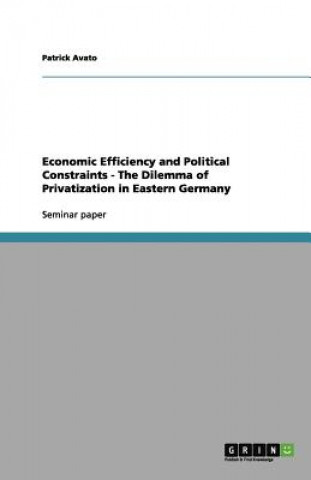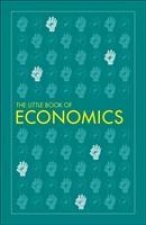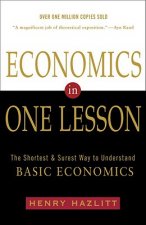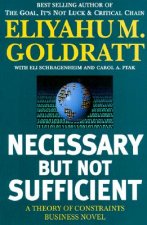
Kód: 01678969
Economic Efficiency and Political Constraints - The Dilemma of Privatization in Eastern Germany
Autor Patrick Avato
Seminar paper from the year 2005 in the subject Business economics - Economic Policy, printed single-sided, grade: A-, Johns Hopkins University (School of Advanced International Studies (SAIS)), course: West European Political Eco ... celý popis
- Jazyk:
 Angličtina
Angličtina - Väzba: Brožovaná
- Počet strán: 28
Nakladateľ: Grin Verlag, 2012
- Viac informácií o knihe

19.60 €
Bežne: 19.62 €
Ušetríte 0.02 €

Skladom u dodávateľa
Odosielame za 8 - 10 dní
Mohlo by sa vám tiež páčiť
-

Wireless Power Transfer for Medical Microsystems
141.15 € -

American Labor's Global Ambassadors
151.77 € -

True Happiness
18.68 € -13 % -

Microsoft Windows Security Essentials
39.31 € -4 % -

voyage to the South Sea, and round the world, perform'd in the years 1708, 1709, 1710, and 1711, by the ships Duke and Dutchess of Bristol. Containing
34.31 € -

The Best American Essays
16.54 € -

The Sower of Tales
13.47 €
Darčekový poukaz: Radosť zaručená
- Darujte poukaz v ľubovoľnej hodnote, a my sa postaráme o zvyšok.
- Poukaz sa vzťahuje na všetky produkty v našej ponuke.
- Elektronický poukaz si vytlačíte z e-mailu a môžete ho ihneď darovať.
- Platnosť poukazu je 12 mesiacov od dátumu vystavenia.
Viac informácií o knihe Economic Efficiency and Political Constraints - The Dilemma of Privatization in Eastern Germany
Nákupom získate 49 bodov
 Anotácia knihy
Anotácia knihy
Seminar paper from the year 2005 in the subject Business economics - Economic Policy, printed single-sided, grade: A-, Johns Hopkins University (School of Advanced International Studies (SAIS)), course: West European Political Economies, 20 entries in the bibliography, language: English, comment: Single spaced. Keywords: Privatization, Privatisierung, DDR, Treuhand, Treuhandanstalt, Germany, Unification, Political Science, Economics , abstract: Firstly, as typical for a centrally planned socialist economy, the great majority of productive capacity belonged to the state. Large, state owned enterprises (Volkseigene Betriebe), often grouped into huge industrial conglomerates (Kombinate), made up 80.7 percent of total assets. Cooperative property accounted for another 14.7 percent in March 1990. Private property merely amounted to 4.7 percent of economic resources and was confined to small-scale businesses, restaurants, and craft shops. Employment was consequently almost entirely in the hand of the state leaving only about 2 percent of the workforce independently employed (Merkl 1994, p. 200). Also, the structure of the GDR economy differed largely from its western counterpart. Employment was heavily concentrated in sectors and branches that had actually been declining in the West. The production was skewed towards agriculture, energy, mining and manufacturing, which together accounted for 47 percent of employment in the GDR (37 percent in the BRD) (Lange and Pugh 1998, p. 32). As shown in table 1 agriculture, forestry and fishery, energy and mining as well as textiles and clothing employed almost 18 percent of the GDR s workforce in contrast to 7 percent in West Germany. Further differences appeared in the service and trade sector which, by Western standards, was rather underdeveloped in the GDR. [...]
 Parametre knihy
Parametre knihy
Zaradenie knihy Knihy po anglicky Economics, finance, business & management Economics
19.60 €
- Celý názov: Economic Efficiency and Political Constraints - The Dilemma of Privatization in Eastern Germany
- Autor: Patrick Avato
- Jazyk:
 Angličtina
Angličtina - Väzba: Brožovaná
- Počet strán: 28
- EAN: 9783656246251
- ISBN: 3656246254
- ID: 01678969
- Nakladateľ: Grin Verlag
- Hmotnosť: 45 g
- Rozmery: 216 × 140 × 2 mm
- Dátum vydania: 31. July 2012
Obľúbené z iného súdka
-

Principles for Dealing with the Changing World Order
23.28 € -9 % -

Team Topologies
23.89 € -12 % -

Freakonomics
9.08 € -10 % -

Misbehaving - The Making of Behavioral Economics
10.61 € -11 % -

Indispensable Milton Friedman
29.41 € -

Little Book of Economics
11.12 € -23 % -

Why Nations Fail
12.45 € -4 % -

Pyramid Principle, The
47.18 € -

Essential Mathematics for Economic Analysis
73.12 € -1 % -

Economics In One Lesson
15.72 € -23 % -

Predictably Irrational
14.90 € -19 % -

Price of Inequality
10.51 € -22 % -

(Mis)Behaviour of Markets
14.39 € -23 % -

Debt, 10th Anniversary Edition
27.98 € -22 % -

A-Level Economics: Year 1 & 2 Complete Revision & Practice (with Online Edition)
28.28 € -9 % -

The Invisible Hand
7.96 € -22 % -

Liar's Poker
13.68 € -

Rational Optimist
13.68 € -

Irrational Exuberance
20.52 € -8 % -

Art of Statistics
10.92 € -24 % -

Scrum - A Pocket Guide - 3rd edition
22.77 € -4 % -

Hypomanic Edge
21.03 € -13 % -

How I Made One Million Dollars Last Year Trading Commodities
41.25 € -19 % -

Misbehavior of Markets
24.61 € -

Econometric Analysis, Global Edition
86.50 € -

Cartoon Introduction to Economics
19.70 € -8 % -

Economics: The User's Guide
12.86 € -24 % -

Rise of Carry: The Dangerous Consequences of Volatility Suppression and the New Financial Order of Decaying Growth and Recurring Crisis
27.67 € -16 % -

Myth of Capitalism - Monopolies and the Death of Competition
23.18 € -20 % -

How Rich Countries Got Rich and Why Poor Countries Stay Poor
16.54 € -23 % -

Business Etiquette in Brief
13.17 € -18 % -

Intermediate Microeconomics and Its Application
105.60 € -

Discovery, Capitalism & Distributive Justice
22.87 € -

Are the Rich Necessary?
13.27 € -1 % -

Economic Point of View
28.18 € -

Driving Digital Transformation
21.95 € -23 % -

Start-Up Nation
9.08 € -24 % -

Economic Facts and Fallacies
16.94 € -20 % -

Decision Book
18.99 € -2 % -

Necessary but Not Sufficient
17.15 € -18 % -

Freakonomics
6.12 € -24 % -

Economics Book
21.13 € -16 % -

Leading at a Higher Level
34.51 € -

Principles of Economics
15.82 € -13 % -

Macroeconomics For Dummies
24.81 € -5 % -

45 Second Presentation That Will Change Your Life
9.90 € -19 % -

Economics of the Public Sector
69.34 € -10 % -

Factfulness
10.20 € -24 % -

Currency Wars
15.82 € -16 %
Osobný odber Bratislava a 2642 dalších
Copyright ©2008-24 najlacnejsie-knihy.sk Všetky práva vyhradenéSúkromieCookies


 21 miliónov titulov
21 miliónov titulov Vrátenie do mesiaca
Vrátenie do mesiaca 02/210 210 99 (8-15.30h)
02/210 210 99 (8-15.30h)